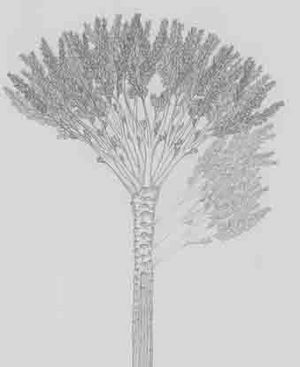Gilboa Fossil Forest facts for kids
The Gilboa Fossil Forest in New York, United States, is an amazing place! It's home to one of the Earth's oldest forests. Imagine trees that grew about 380 million years ago during the Devonian Period. That's super old! These special tree fossils are found near the Gilboa Dam in Schoharie County. They are some of the only ones of their kind left in the world. Scientists called paleobotanists (people who study ancient plants) have been very interested in this area since the 1920s. That's when New York City started building a dam and found these incredible fossils. You can even see some of these ancient tree stumps on display at the Gilboa Dam site (42°24′1.46″N 74°27′0.49″W / 42.4004056°N 74.4501361°W), the New York Power Authority Blenheim-Gilboa Visitor's Center, and the New York State Museum.
Discovering Earth's Oldest Trees
An international team of scientists has found proof of the Earth's very first forest trees. These trees lived about 385 million years ago. More than a hundred years ago, after a big flood in Gilboa, New York, upright fossilized tree stumps were found. But until 2007, scientists didn't know what the tops of these trees looked like. They also didn't know their full shape.
These ancient trees grew along the coast of an inland sea. This sea once covered what is now southern New York and western Pennsylvania. Scientists like William Stein from Binghamton University, along with colleagues from the New York State Museum and Cardiff University in the United Kingdom, made an exciting discovery. They found a complete tree that was more than 26 feet tall! It had frond-like branches but no leaves. This made it look a bit like a tree fern or a palm tree.
What Made These Trees Special?
These findings helped scientists understand that these trees, called Eospermatopteris, belonged to a group called Cladoxylopsida. These were large plants with a very unique shape for their time.
Scientists are very excited about these trees because they were part of "afforestation." This is the name for the original "greening" of the Earth. When forests first grew, it had a huge effect on our planet.
- It changed the Earth's climate.
- It affected how carbon moved through the environment.
- It even influenced what kinds of animals developed in these early ecosystems.
Dr. Berry from Cardiff explained that the growth of these first forests was a big moment for the planet. He said, "The rise of the forests removed a lot of carbon dioxide from the atmosphere. This caused temperatures to drop. The planet then became very similar to how it is today."
New Home for Ancient Fossils
Nine fossil trees, about 370 million years old, are being moved to a new location. This new spot is about half a mile from the Gilboa Dam overlook. This news was shared by Commissioner Joel A. Miele Sr. from the New York City Department of Environmental Protection (DEP) and Kristen V. H. Wyckoff from the Gilboa Historical Society.
The DEP is lending these rare fossil trees to the Gilboa Historical Society. They will be part of a new exhibit and an educational display. This new display will be on land owned by the town of Gilboa. This means more people will be able to learn about these incredible ancient trees!


